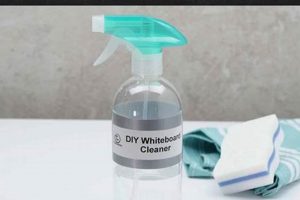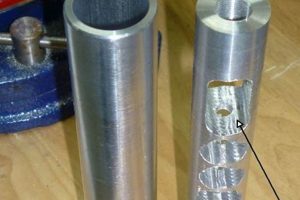Creating aromatic compounds at home for therapeutic or fragrance purposes involves a process of extraction, often from plant materials. These homemade concoctions aim to replicate the properties of commercially available concentrated plant extracts. For example, infusing a carrier oil with dried lavender flowers using a slow heating method constitutes a basic approach to crafting a personalized scented oil.
The appeal of producing these customized blends stems from factors such as cost savings, control over ingredients, and the satisfaction derived from a hands-on activity. Historically, individuals have relied on similar techniques to harness the natural benefits of plants. The resulting products can be utilized in aromatherapy, skincare, or as natural household scents, offering a potential alternative to synthetic fragrances and commercially processed products. Furthermore, engaging in such activities promotes a deeper understanding of botany and traditional remedies.
Subsequent sections will explore specific methods for creating these plant-based aromatic products, address safety considerations, and discuss appropriate applications of the resulting preparations. Detailed information regarding plant selection, extraction techniques, and proper storage protocols will also be provided. This exploration aims to empower individuals to safely and effectively produce their own personalized aromatic blends.
DIY Essential Oil
Producing concentrated plant extracts at home requires careful consideration of safety, technique, and appropriate application. The following tips provide essential guidance for successful and responsible creation of these aromatic products.
Tip 1: Source High-Quality Plant Material: The effectiveness of the final product depends heavily on the quality of the starting ingredients. Opt for organic, sustainably harvested herbs and botanicals whenever possible. Inspect plant material for signs of mold, damage, or contamination before use.
Tip 2: Understand Extraction Methods: Different plants require different extraction techniques. Maceration, enfleurage, and distillation are common methods, each yielding varying levels of concentration and aroma profile. Research the appropriate technique for the specific plant being used.
Tip 3: Exercise Extreme Caution with Heat: When using heat for extraction, maintain a low and controlled temperature. Overheating can degrade the aromatic compounds and create potentially harmful byproducts. Use a double boiler or slow cooker to regulate temperature effectively.
Tip 4: Dilute Appropriately: Concentrated plant extracts are potent and should always be diluted before topical application. Use a carrier oil, such as jojoba, almond, or grapeseed oil, at a dilution ratio appropriate for the intended use and the specific extract. A general guideline is 1-3% dilution for adults.
Tip 5: Perform a Patch Test: Before applying a diluted preparation to a large area of skin, conduct a patch test on a small, inconspicuous area. Monitor for any signs of irritation, redness, or allergic reaction for at least 24 hours.
Tip 6: Store Properly: Store homemade concentrates in dark-colored glass bottles away from direct sunlight and heat. Properly stored, they can maintain their potency and aroma for several months. Label each bottle with the date of production and the ingredients used.
Tip 7: Research Potential Interactions: Certain plant extracts can interact with medications or have contraindications for specific health conditions. Consult with a healthcare professional or qualified aromatherapist before using homemade preparations, especially if pregnant, breastfeeding, or have underlying health concerns.
Effective creation and utilization relies heavily on selecting appropriate materials, understanding safe extraction practices, and employing proper dilution and storage methods. Prioritizing safety and adhering to established guidelines will ensure the enjoyment and benefits of these homemade aromatic creations.
The subsequent sections will delve into advanced extraction techniques and detailed safety guidelines for utilizing homemade aromatic plant products.
1. Plant Selection
The selection of plant material is a foundational element in the creation of homemade aromatic compounds. The characteristics of the chosen botanical directly influence the quality, potency, and safety of the final extract. Careful consideration must be given to factors such as plant species, chemotype, and growing conditions.
- Species Specificity
The specific species of plant used determines the chemical composition of the resultant product. For instance, Lavandula angustifolia yields a different aromatic profile and therapeutic properties compared to Lavandula latifolia. Incorrect species identification can lead to unexpected and potentially undesirable outcomes.
- Chemotype Variation
Within a single plant species, chemotypes represent variations in chemical composition due to genetic or environmental factors. Rosemary, for example, exhibits different chemotypes characterized by varying levels of camphor, cineole, or verbenone. Selection of a specific chemotype is crucial when targeting particular therapeutic effects.
- Cultivation Practices
The methods used to cultivate plants significantly impact the quality of the final product. Organically grown plants, free from synthetic pesticides and herbicides, are generally preferred to minimize potential contamination. Sustainable harvesting practices ensure the long-term availability of plant resources and minimize environmental impact.
- Plant Maturity and Condition
The stage of plant maturity at the time of harvest influences the concentration and profile of aromatic compounds. Flowers harvested at peak bloom, or leaves collected during specific seasons, may exhibit optimal chemical composition. Diseased or damaged plant material should be avoided, as it can compromise the integrity and safety of the extract.
The interconnectedness of these facets emphasizes the critical role of plant selection in the context of homemade plant extracts. Careful assessment of species, chemotype, cultivation practices, and plant condition ensures a safe, effective, and sustainable approach to creating personalized aromatic products.
2. Extraction Method
The method employed to extract aromatic compounds from plant material is a critical determinant of the final product’s composition, quality, and intended use. The chosen extraction technique directly influences the concentration of desired constituents, the presence of unwanted compounds, and the overall safety profile of the homemade aromatic preparation.
- Steam Distillation
This process involves passing steam through plant mater
ial to vaporize volatile compounds, which are then condensed and collected. Steam distillation typically yields a relatively pure product, free of non-volatile plant components. However, it may not be suitable for all plants, as some delicate aromatic molecules can be degraded by heat. This method is commonly used for extracting compounds from plants like lavender and peppermint. The resulting distillate contains both the aqueous hydrosol and the aromatic extract. - Maceration
Maceration involves soaking plant material in a solvent, such as a carrier oil, to dissolve the aromatic compounds. This method is simpler and requires less specialized equipment than steam distillation, making it accessible for home use. However, maceration extracts a broader range of compounds, including non-volatile components like plant waxes and pigments, which can affect the aroma and texture of the final product. Common examples include infusing olive oil with calendula flowers or extracting vanilla bean flavor into vodka.
- Solvent Extraction
This method utilizes solvents such as ethanol or hexane to dissolve aromatic compounds from plant material. Solvent extraction is efficient for extracting a wide range of compounds, including those that are not readily extracted by steam distillation or maceration. However, the use of potentially hazardous solvents requires specialized equipment and safety precautions. Residual solvent contamination is a significant concern and requires careful monitoring. This technique is often used in the commercial production of absolutes and resinoids.
- Expression (Cold Pressing)
Expression, or cold pressing, is primarily used to extract aromatic compounds from citrus fruit peels. The peels are mechanically pressed to release the oil, which is then separated from the juice and pulp. This method yields a product that closely resembles the natural aroma of the fruit. However, expressed oils can be more prone to oxidation and degradation due to the presence of waxes and other non-volatile components. Examples include lemon, orange, and grapefruit peel extractions.
The selection of an appropriate extraction method is paramount to the creation of high-quality homemade aromatic plant extracts. The characteristics of the plant material, the desired aroma profile, and the available equipment and resources must all be considered. Understanding the principles and limitations of each extraction technique ensures a safe and effective approach to producing personalized aromatic products.
3. Safety Precautions
The creation of aromatic plant extracts at home necessitates rigorous adherence to safety protocols to mitigate potential risks. The process of deriving these compounds, while seemingly straightforward, involves manipulation of concentrated plant materials and, in some instances, potentially hazardous substances or equipment. Failure to observe appropriate safety precautions can lead to adverse health effects, property damage, or environmental contamination. A fundamental aspect of safe practice is comprehensive knowledge of the plants being utilized. Certain botanicals may contain inherent toxins or allergens that require careful handling and dilution. For example, improper handling of pennyroyal (Mentha pulegium) can lead to severe liver damage due to its high pulegone content. Precise identification and a thorough understanding of the plant’s chemical composition are thus paramount.
Furthermore, extraction methods themselves pose inherent risks. Steam distillation, while generally considered safe, involves the use of hot water and steam, presenting a risk of burns and scalds. Solvent extraction, often employed to obtain higher yields or specific aromatic constituents, requires the use of flammable and potentially toxic solvents such as ethanol or hexane. Proper ventilation, personal protective equipment (PPE), and adherence to strict protocols for solvent handling and disposal are essential to prevent explosions, fires, and inhalation of harmful vapors. Maceration, although less hazardous than solvent extraction, still requires careful consideration of the carrier oil used. Rancid or contaminated carrier oils can lead to skin irritation or allergic reactions. Moreover, the final product’s concentration and application method necessitate careful attention to dilution ratios. Undiluted plant concentrates can cause skin sensitization, phototoxicity, or systemic toxicity if ingested. For instance, direct application of undiluted citrus oils can result in severe sunburn due to their phototoxic properties.
In summary, safety precautions are not merely an adjunct to the creation of homemade aromatic plant extracts but rather an integral component that dictates the entire process. From plant selection and extraction method to dilution and application, each step demands meticulous attention to detail and unwavering adherence to established safety guidelines. Ignorance or disregard of these precautions can have severe consequences, underscoring the importance of education, responsible practice, and a healthy respect for the inherent power and potential hazards associated with concentrated plant extracts. A crucial consideration should involve consulting with qualified professionals, such as aromatherapists or herbalists, prior to initiating any home extraction process.
4. Dilution Ratios
Dilution ratios represent a critical safety and efficacy parameter in the practice of creating plant-derived aromatic preparations. The concentration of bioactive compounds within extracted plant essences necessitates precise dilution to avoid adverse reactions and to optimize therapeutic benefits. Therefore, understanding and applying appropriate dilution ratios is fundamental to responsible utilization of these homemade products.
- Safety Considerations for Topical Applications
Topical application of undiluted aromatic extracts can lead to skin irritation, sensitization, or phototoxicity. Dilution with a suitable carrier oil, such as jojoba or almond oil, reduces the concentration of potentially irritating compounds and allows for safe absorption through the skin. A general guideline suggests a 1-3% dilution for adults, while children, the elderly, and individuals with sensitive skin require even lower concentrations. For example, a 2% dilution would involve adding 2 drops of plant essence to 100 drops (approximately 5 ml) of carrier oil.
- Aromatic Diffusers and Inhalation
When using diffusers to disperse plant essences into the air, dilution considerations shift from direct skin contact to respiratory exposure. The concentration of aromatic compounds in the air should be carefully controlled to avoid respiratory irritation or sensitization. Intermittent diffusion, rather than continuous exposure, is recommended, and the size of the room should be considered when determining the appropriate number of drops to use. Generally, 3-5 drops in a diffuser with water are sufficient for an average-sized room. Overexposure can lead to headaches, nausea, or respiratory distress.
- Internal Use and Contraindications
Internal use of self-made aromatic concentrates is generally discouraged due to the potential for toxicity and unpredictable interactions with medications. Only qualified healthcare professionals should administer plant-derived aromatics internally, and only when appropriate fo
r the specific condition and individual. Certain plant essences are contraindicated for pregnant or breastfeeding women, individuals with liver or kidney disease, or those taking specific medications. Consultation with a healthcare provider is essential to determine the safety and appropriateness of internal use. - Variable Potency of Homemade Extracts
Unlike commercially produced, standardized plant essences, homemade extracts can exhibit significant variability in potency due to factors such as plant quality, extraction method, and storage conditions. This variability necessitates a cautious approach to dilution ratios, starting with lower concentrations and gradually increasing as needed, while closely monitoring for any adverse reactions. Regular olfactory assessment and record-keeping can help track changes in the extract’s aroma and potency over time. If the extract smells stronger or weaker than before, adjustments to dilution ratios are imperative.
The nuances of dilution ratios underscore the importance of informed decision-making when preparing plant essences. The ultimate goal is to achieve the desired therapeutic effect while minimizing the risk of adverse reactions. Adhering to established guidelines, consulting with qualified professionals, and exercising caution are paramount to the safe and responsible use of homemade aromatic preparations. Individual tolerance levels can vary, therefore what may be acceptable for one person can cause adverse effects to another, it’s important to always exercise caution with this process.
5. Storage Protocols
Proper storage protocols are paramount to maintaining the integrity, potency, and safety of homemade plant essences. Deviations from established storage guidelines can lead to degradation of the aromatic compounds, contamination of the product, and potential health hazards. Consequently, a thorough understanding of appropriate storage practices is essential for individuals engaged in the creation of these preparations.
- Container Selection
The choice of container significantly impacts the stability of the enclosed aromatic concentrate. Dark-colored glass bottles, specifically amber or cobalt blue, are recommended to minimize exposure to light, which can degrade photosensitive compounds. Clear glass containers should be avoided. Furthermore, the cap material is crucial; airtight closures, such as phenolic caps or Teflon-lined lids, prevent oxidation and evaporation of volatile components. Plastic containers are generally unsuitable due to the potential for leaching and degradation of the plastic by the plant concentrate.
- Temperature Control
Elevated temperatures accelerate the degradation of aromatic compounds, leading to a loss of potency and alteration of the aroma profile. Homemade plant essences should be stored in a cool, dark location away from direct heat sources such as sunlight, radiators, or ovens. A consistent temperature between 60F and 75F (15C and 24C) is ideal. Fluctuations in temperature can also contribute to degradation; therefore, avoiding locations with significant temperature swings is recommended.
- Protection from Light
Exposure to light, particularly ultraviolet (UV) radiation, can trigger photochemical reactions that alter the chemical composition of plant essences. This can result in the formation of undesirable byproducts, loss of therapeutic properties, and changes in aroma. Storing plant essences in dark-colored bottles and placing them in a closed cabinet or box provides optimal protection from light exposure. Direct sunlight should be avoided at all costs.
- Minimizing Oxygen Exposure
Oxidation is a primary cause of degradation in plant essences. Exposure to oxygen can lead to the formation of peroxides and other oxidation products, altering the aroma and reducing the potency of the preparation. To minimize oxygen exposure, it is important to ensure that the container is tightly sealed and that the headspace (the air space above the liquid) is minimized. Transferring the plant essence to a smaller container as the volume decreases can help reduce headspace. Inert gas blanketing, a technique used in commercial production, is generally not practical for home use.
The implementation of appropriate storage protocols is not merely a matter of preserving the aroma of homemade plant essences; it is a fundamental aspect of ensuring their safety, efficacy, and longevity. By adhering to established guidelines for container selection, temperature control, light protection, and oxygen minimization, individuals can maximize the benefits of their homemade aromatic preparations and minimize the risk of adverse effects. Consistent application of these protocols is critical for maintaining the quality and integrity of the final product.
6. Application Methods
The effectiveness and safety of homemade aromatic preparations are inextricably linked to the method of application. The route through which these plant-derived compounds enter the body dictates the extent of systemic absorption, the potential for targeted therapeutic action, and the risk of adverse effects. The selection of an appropriate application method is therefore a crucial step in the responsible utilization of these preparations.
Topical application, involving the direct application of diluted essences to the skin, is a common method for addressing localized conditions. Examples include applying lavender-infused oil to minor burns or utilizing chamomile-infused preparations for skin irritation. Transdermal absorption allows for targeted delivery to the affected area, while systemic absorption is generally limited. However, factors such as the concentration of the essence, the surface area of application, and the presence of penetration enhancers can influence the extent of systemic uptake. Inhalation, another prevalent method, involves inhaling the vaporized essences, either through direct inhalation from a bottle or through the use of a diffuser. This route allows for rapid absorption into the bloodstream via the respiratory system, making it suitable for addressing respiratory ailments or promoting relaxation. Direct inhalation delivers a higher concentration of aromatic compounds compared to diffusion, requiring careful monitoring to avoid respiratory irritation. Aromatic baths offer a gentler alternative, allowing for both inhalation and topical absorption. The warm water enhances skin permeability, while the vaporized essences stimulate olfactory receptors. However, the dilution factor in bathwater is significant, requiring a higher quantity of essence to achieve the desired effect.
Internal use of homemade aromatic preparations carries the highest risk and should be approached with extreme caution or generally avoided. The gastrointestinal tract is highly sensitive to concentrated plant extracts, and improper use can result in severe digestive upset, liver damage, or systemic toxicity. Unless specifically directed and supervised by a qualified healthcare professional, internal use of these essences is strongly discouraged. Ultimately, the choice of application method should be guided by a thorough understanding of the plant essence’s properties, the intended therapeutic outcome, and the individual’s health status. Prudence, caution, and a commitment to safety are paramount in the responsible application of these homemade aromatic prepara
tions.
Frequently Asked Questions
This section addresses common inquiries regarding the creation and utilization of plant-based aromatic compounds, providing concise and informative answers to prevalent concerns.
Question 1: Are aromatic plant concentrates created at home chemically identical to commercially produced essences?
The chemical composition of homemade aromatic concentrates can vary significantly from commercially produced essences. Factors such as plant quality, extraction method, and equipment influence the final product’s profile, potentially leading to differences in efficacy and safety.
Question 2: Is “diy essential oil” cost-effective compared to purchasing commercially available options?
The cost-effectiveness depends on various factors, including the availability and price of raw materials, equipment costs, and the volume of production. While creating these concentrates at home can be more economical in some cases, it may require a significant initial investment.
Question 3: What safety precautions are essential when creating plant extracts at home?
Essential safety precautions include proper ventilation, use of personal protective equipment, careful handling of solvents (if applicable), appropriate dilution ratios, and thorough research into potential hazards associated with the plant material used.
Question 4: How should homemade aromatic concentrates be stored to maintain their potency and safety?
Proper storage involves using dark-colored glass bottles, storing the product in a cool, dark location, minimizing exposure to oxygen, and regularly checking for signs of degradation or contamination.
Question 5: Can these homemade aromatic blends be used for therapeutic purposes?
The therapeutic efficacy of homemade preparations depends on factors such as the quality of ingredients, the extraction method, and the individual’s sensitivity. Consultation with a qualified healthcare professional is essential before using them for therapeutic purposes.
Question 6: What are the common signs of an adverse reaction to topically applied aromatic preparations?
Common signs of an adverse reaction include skin irritation, redness, itching, burning, blistering, or allergic reactions. A patch test should be conducted before applying the concentrate to a large area of skin.
In summary, the creation and utilization of plant-based aromatic blends requires careful consideration of safety, efficacy, and storage to ensure optimal results and minimize potential risks.
The subsequent sections will explore advanced extraction techniques and detailed safety guidelines for utilizing homemade aromatic plant products.
Conclusion
This exploration of “diy essential oil” creation highlights the necessity for both informed methodology and rigorous safety adherence. From meticulous plant selection to precise extraction techniques, each stage demands careful consideration. Effective application hinges upon proper dilution and a comprehensive understanding of potential contraindications. The inherent variability in homemade aromatic concentrates necessitates a cautious approach.
Responsible engagement with these plant-derived aromatic compounds requires continuous learning and a commitment to safety. Further research and consultation with qualified professionals are encouraged to ensure responsible and effective utilization of “diy essential oil” techniques. The potential benefits are considerable, but these benefits are contingent upon informed and cautious practice.







